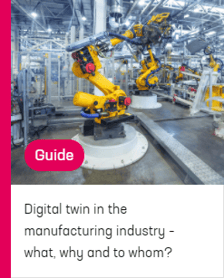
Production simulation enables carrying out quick experiments in a virtual world before putting them into practice. In many situations, simulation is a more agile, cheaper and more straightforward way to experiment that real-life testing.
In simulation, the old saying is particularly true: the quality of the result is proportional to the quality of the input (“You get what you give”). It is therefore crucial that production simulation is carried out using accurate and realistic data. This applies to the incoming material flows as well as to the capacities and parameters of the machines and equipment involved in the simulation or, for example, the warehouses, not forgetting the various routing options.
Production simulation starts with data collection
Data collection usually constitutes the bulk of the client’s work in a simulation project. The amount of work and time required for collection varies. There are projects where the output data are ready in a few days, but in most cases it takes a few weeks before all the data are collected, aggregated, and processed.
In the best case, the company will have a designated data processor who knows the systems and tools, and is able to produce almost finished data independently. Often, data are collected from many systems and experts. If historical data suitable for simulation are not available (e.g. green field project), they will be created based on best knowledge and experience.
Making the most of data is challenging
The amount of data is rarely a problem nowadays; it is there. Making use of the data is a different matter. A production simulation project can be the first “customer” to take advantage of years of data. At this stage, you may find that the quality of the data is not quite what you expected. It may also come as a surprise, for example, that data are retained for only a week, when simulating production would require data for a few months.
The simulation model does not understand the wrong data or results in erroneous output due to incorrect input data. There may be millions of rows of data, so it is understandable that it takes time to review it. As the project progresses, it should be mutually agreed whether to delete or correct the incorrect data.
If the data have been collected manually, it will almost invariably need to be reviewed. There may be incorrect data, blank fields, text in the number fields, work steps recorded with the same timestamp and many other problems. The simulation model does not understand the wrong data or results in erroneous output due to incorrect input data. There may be millions of rows of data, so it is understandable that it takes time to review it. As the project progresses, it should be mutually agreed whether to delete or correct the incorrect data.
Data are automatically collected data in a regular and quantifiable format, which is helpful when using them in a simulation project. Data can be collected automatically using machine monitoring, production planning and maintenance tools, among others.
The actual data validate the simulation model
It is worth validating the simulation model with historical data, i.e. ensure that the production simulation works as intended. By entering the feed to the model from a table, you know exactly what to expect and when. However, this kind of row data may limit the ability to run different scenarios. For example, if you aim to increase production by 10%, it can be challenging to produce the right number of extra rows; we are trapped in so-called row data. It is therefore generally useful to create a distribution of the actual data, according to which, for example, different raw materials are fed into the model. This makes scaling easier.
Often, a large part of the data is only validated at the modeling stage. The data are in the right format, but when you run the model, you notice that something’s wrong. As you can see, there are many steps in collecting and analyzing data for simulation. However, this step produces results in itself. The data can be used to infer many things even before the actual simulation results are available, creating fruitful discussions and observations between the different parties.
Read more from the guide: Digital twin in the manufacturing industry
Read more
Success story Metsä Fibre
Manufacturing simulation services – Digital Twin
Simulation services

Aku Mäkimattila
I work as a solutions consultant at Pinja. In my work, I look for additional efficiency to customer production and logistics. In my free time, I play in a band with my children.
Back to the Pinja Blog
Categories
- Career at Pinja (68)
- Manufacturing (48)
- Knowledge Management (45)
- Production Development (44)
- Software Partnership & Tools (42)
- Sustainability (37)
- Wood and Forestry (37)
- Bioenergy and Recycling (27)
- IT Support and Outsourcing (24)
- Ecommerce (23)
- Maintenance (22)
- Artificial Intelligence and Machine Learning (15)
- Public Services (9)
- Compliance (1)
